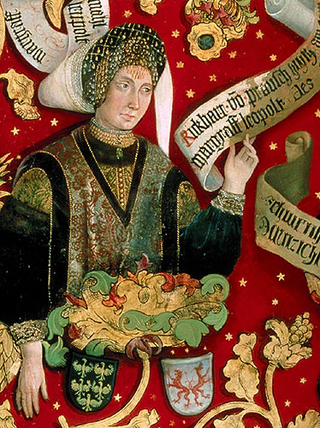
Lotharingia was a medieval successor kingdom of the Carolingian Empire. It comprised present-day Lorraine (France), Luxembourg, Saarland (Germany), Netherlands, most of Belgium, and Germany west of the Rhine. It was named after King Lothair II, who received this territory as his share of the Kingdom of Middle Francia which his father, Lothair I, had held.

Hedwige of Saxony, a member of the Ottonian dynasty, was Duchess consort of the Franks by her marriage to the Robertian duke Hugh the Great. Upon her husband's death in 956, she acted as a regent during the minority of their son Hugh Capet, the founder of the Elder House of Capet.

Lothair, sometimes called Lothair II, III or IV, was the penultimate Carolingian king of West Francia, reigning from 10 September 954 until his death in 986.
Rudolph I was King of Upper Burgundy from his election in 888 until his death.
Rudolph II, a member of the Elder House of Welf, was King of Burgundy from 912 until his death. He initially succeeded in Upper Burgundy and also ruled as King of Italy from 922 to 926. In 933 Rudolph acquired the Kingdom of Lower Burgundy (Provence) from King Hugh of Italy in exchange for the waiver of his claims to the Italian crown, thereby establishing the united Kingdom of Burgundy.

Berengar II was the King of Italy from 950 until his deposition in 961. He was a scion of the Anscarid and Unruoching dynasties, and was named after his maternal grandfather, Berengar I. He succeeded his father as Margrave of Ivrea around 923, and after 940 led the aristocratic opposition to kings Hugh and Lothair II. In 950 he succeeded the latter and had his son, Adalbert crowned as his co-ruler. In 952 he recognised the suzerainty of Otto I of Germany, but he later joined a revolt against him. In 960 he invaded the Papal States, and the next year his kingdom was conquered by Otto. Berengar remained at large until his surrender in 964. He died imprisoned in Germany two years later.
Adalbert II, called the Rich, son of Adalbert I, Margrave of Tuscany and Rothild of Spoleto. He was a grandson of Boniface II, and was concerned with the troubles of Lombardy, at a time when so many princes were contending for the wreckage of the Carolingian Empire. Before his father died in 884 or 886, he is accredited the title of "count". He inherited from his father the titles of Count and Duke of Lucca and Margrave of Tuscany.
Otto, son of Count Ricwin and a Liudolfing, was the Count of Verdun by inheritance and the Duke of Lorraine by appointment. Otto I, Holy Roman Emperor appointed him to Duke. Otto was a relative of the emperor, hence both his name and his appointment to high office. He is sometimes referred to as Otto I because another Otto later ruled over Lower Lorraine.

Godfrey I, called the Prisoner or the Captive, sometimes the Old, was the count of Bidgau and Methingau from 959 and the sovereign count of Verdun 963 to his death. In 969, he obtained the Margraviate of Antwerp and Ename. Between 974 and 998, he was also the sovereign count of Hainault and Mons.
The County of Verdun was a sovereign medieval county in the Duchy of Lower Lorraine.
Burchard II was the Hunfriding Duke of Swabia and Count of Raetia. He was the son of Burchard I of Swabia and Liutgard of Saxony.
Guy I was the Duke of Spoleto from 842. He was the son of Lambert I of Nantes and Adelaide of Lombardy, the eldest daughter of Pepin of Italy. He travelled with his father in 834 in the entourage of Lothair I. He was given the abbey of Mettlach, Lotharingia in 840, when the Emperor Louis the Pious died.
Gerold I was the count of Kraichgau and Anglachgau. His daughter, Hildergard married King Charlemagne in 771.
Hugh or Hugo was an illegitimate son of Lothair II, king of Lotharingia, by his mistress Waldrada. His father made him Duke of Alsace in 867.
Henry was the leading military commander of the last years of the Carolingian Empire. He was commander-in-chief under Kings Louis the Younger and Charles the Fat. His early career was mostly restricted to East Francia, his homeland, but after Charles inherited West Francia in 884 he was increasingly active there. During his time, raids by the Vikings peaked in Francia. The sources describe at least eight separate campaigns waged by Henry against the Vikings, most of them successful.

Hedwig, was Duchess of Saxony by her marriage with the Liudolfing duke Otto the Illustrious. She is the mother of King Henry the Fowler.

Richardis of Sualafeldgau was Margravine of Austria from 976 until 994 as consort of the first Babenberg margrave Leopold I.
Engelram was Chamberlain to Charles the Bald through sometime after 871. He also held the title of count from 853, but it is unclear what his domain was. Nothing is known about his ancestry.
Ricwin , was a Count of Verdun.
Willa of Burgundy was a member of the Elder House of Welf. By birth she was a daughter of Rudolph I of Burgundy, king of Upper Burgundy. Through marriage Boso Willa became countess of Avignon and Arles, and then margravine of Tuscany.






